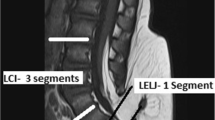Abstract
Introduction
Lipomyelomeningoceles (LMM) occur in approximately 1 in every 4,000 live births in the United States. They are associated with a wide range of problems in affected patients, including skin abnormalities, sensory and motor deficits, pain, urinary bladder and anal sphincter dysfunction, and orthopedic deformities.
Materials and methods
In an effort to better understand the orthopedic complications associated with LMM, the present study examined the long-term orthopedic deformities in 50 patients after surgical correction of their LMM and observed for correlation between these deformities and the type and level of LMM.
Results
Analysis of the collected data revealed a statistically significant relationship between of the type of LMM and the presence of orthopedic complications. However, no statistically significant relationship existed between the vertebral level of the LMM and the presence of orthopedic deformities. No correlation was identified between the level and type of LMM.
Conclusion
In this study, caudal LMM were much more likely than either dorsal or transitional types to have orthopedic complications. These data may prove useful to clinicians in predicting outcome and in counseling patients and their parents.
Similar content being viewed by others
References
Blount J, Elton S (2001) Spinal lipomas. Neurosurg Focus 10:e3
Chapman PH, Davis KR (1993) Surgical treatment of spinal lipomas in childhood. Pediatr Neurosurg 19:267–275
Kumar R, Singh SN (2003) Spinal dysraphism: trends in northern India. Pediatr Neurosurg 38:133–145
Sutton LN (1995) Lipomyelomeningoceles. Neurosurg Clin N Am 6:325–338
Cochrane D, Finley, C, Kestle J, Steinbok P (2001) The patterns of late deterioration in patients with transitional lipomyelomeningoceles. Eur J Pediatr Surg 10:13–17
Herman J, McLone D, Storrs B, Dauser R (1993) Analysis of 153 patients with myelomeningocele or spinal lipoma reoperated upon for a tethered cord. Pediatr Neurosurg 19:243–249
Tubbs RS, Naftel RP, Rice WC, Liechty P, Conklin M, Oakes WJ (2006) The patient with symptoms following resection of a lipomyelomeningocele: do increases in the lumbosacral angle indicate a tethered spinal cord? J Neurosurg 105:62–64
Yamada S, Iacono R, Yamada B (1996) Pathophysiology of the tethered spinal cord. In: Yamada S (ed) Tethered cord syndrome. American Association of Neurological Surgeons, Park Ridge, IL, pp 29–45
Colak A, Pollack I, Albright AL (1998) Recurrent tethering: a common long-term problem after lipomyelomeningocele repair. Pediatr Neurosurg 29:184–190
Schoenmakers M, Gooskens R, Gulmans V, Hanlo PW, Vandertop WP, Uiterwaal CS, Helder PJ (2003) Long-term outcome of neurosurgical untethering on neurosegmental motor and ambulation levels. Dev Med Child Neurol 45:551–555
Author information
Authors and Affiliations
Corresponding author
Rights and permissions
About this article
Cite this article
Tubbs, R.S., Winters, R.G., Naftel, R.P. et al. Predicting orthopedic involvement in patients with lipomyelomeningoceles. Childs Nerv Syst 23, 835–838 (2007). https://doi.org/10.1007/s00381-007-0342-5
Received:
Published:
Issue Date:
DOI: https://doi.org/10.1007/s00381-007-0342-5




